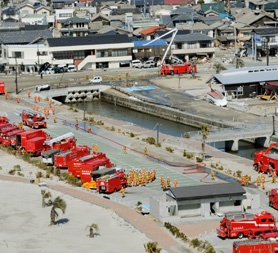Japan: UN atomic body to hold extraordinary meeting
As Japan’s nuclear body raises the level of the nuclear crisis from 4 to 5 on a scale of 7, the International Atomic Energy Agency announces it will meet on Monday.

Yukiya Amano, head of the International Atomic Energy Agency said on Friday that the UN atomic watchdog will hold an extraordinary meeting to discuss Japan’s nuclear plants on Monday.
Mr Amano told journalists that the situation at the damaged plant is: “very grave and serious”, and called for the international community to help Japan: “It is important that the international community, including the IAEA, handles this jointly. This is a race against time.”
Earlier on Friday, Japan raised the severity rating of the ongoing disaster from 4 to 5 on a 7 point international nuclear scale. That makes it the same level as the Three Mile Island accident in the United States in 1979, where a partial meltdown of the reactor core released radiation. The Chernobyl accident of 1986 was ranked a level 7.
Over 300 hundred workers are now working at the Fukisham Daiichi site, trying to restore power so that they can get the cooling systems restored for the six reactors at the plant. The reactors have been hit by explosions and fires and are leaking radiation.
Firefighters are dousing water on damaged buildings with hoses and police water cannons. Japanese engineers are reportedly trying to restore a power cable to the complex that could get water pumps working again.
Japan is transfixed by the fate of the workers, who are risking exposure to very high levels of radiation to carry out the work. Local media have been reporting on notes left by workers for their families wishing them well. “My eyes well with tears at the thought of the work they are doing,” said Kazuya Aoki, a safety official at Japan’s Nuclear and Industrial Safety Agency.
But Tokyo Electric, who are running the operation, is limiting the amount of radiation to which the workers can be exposed. The average dose for a nuclear plant worker is 50 millisieverts over five years. Tokyo Electric said on Friday that it had raised the limit for the emergency work to 100 millisieverts an hour, subject to an overall maximum of 250 millisieverts a year.
The Chief Secretary of Japan’s cabinet, Yukio Edano tried to calm fears about the radiation. He said the leak from the plant “is not so high as to immediately affect human health”.
Japan exodus
But fears of the radiation are creating travel problems as large numbers of foreigners try to leave Japan. The first plane chartered by the Foreign Office for Britons wanting to leave Japan left on Friday morning. Two more are due to leave on Saturday.
Britons are being advised to use commercial flights where possible but those directly affected by the quake will get help returning home. More information is available on the Foreign Office website.
Some leading scientists say the fears of a meltdown on the level of Chernobyl are an over-reaction. Professor Gerry Thomas told Channel 4 News: “We are panicking that poor, savaged population about radiation that is not going to harm them.”
Japan held a minute’s silence on Friday, to mark seven days since the earthquake and tsunami that destroyed the country and damaged the reactors. Since then, 6,400 people have been confirmed dead, police say. Tens of thousands are missing. In the affected areas there are shortages of petrol, food and water.
Professor Thomas said that focus on the nuclear crisis was detracting from the real humanitarian problem: “Tens of thousands of people have lost their lives. Even if the worse case scenario happened and there was an accident ten times the size of Chernobyl, you wouldn’t have as many deaths as that. We are missing the point here.”